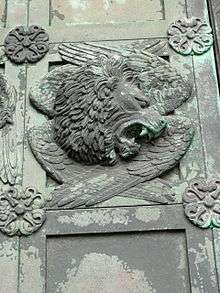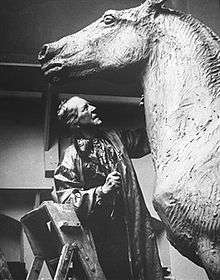Anne Marie Carl-Nielsen
Anne Marie Carl-Nielsen (born Anne Marie Brodersen; 21 June 1863 – 22 February 1945) was a Danish sculptor. Her preferred themes were domestic animals and people, with an intense, naturalistic portrayal of movements and sentiments. She also depicted themes from Nordic mythology. She was "one of the first women to be taken seriously as a sculptor," a trend-setter in Danish art for most of her life.[1] She was married to the Danish composer Carl Nielsen.
Anne Marie Carl-Nielsen | |
|---|---|
 Anne Marie Carl-Nielsen working on a sculpture | |
| Born | Anne Marie Brodersen 21 June 1863 Sønder Stenderup, Denmark |
| Died | 22 February 1945 (aged 81) Copenhagen, Denmark |
| Nationality | Danish |
| Known for | Sculpture |
Notable work |
|
| Awards |
|
Early life
Brodersen was born on Thygesminde, a large farm estate in South Stenderup, near Kolding. Her father Povl Julius Brodersen served in the German Dragoons before purchasing the farm. He married Friderikke Johanne Kirstine Gilling, who was his housekeeper. The Brodersens were "successful, daring people",[2] some of the first to import livestock directly from England. Anne Marie was thus familiar with farming and animals from an early age.[3]
Her first work, a small sheep using clay from the farm garden, dates from 1875. From 1881–1882 she trained at schools for carving and for drawing and applied art. She also studied with sculptor August Saabye and painters Jørgen Roed and Henrik Olrik. She first exhibited work at Charlottenborg Spring Exhibition in 1884. She was awarded first prize in Neuhausen's competition in 1887 for a fountain group Thor with the Midgard Serpent (Thor med Midgaardsormen) which she completed in Saabye's studio.[4]
In 1889 she was awarded a scholarship from the Art School for Women (Kunstskolen for Kvinder). She travelled to the Netherlands, Belgium and Paris where she visited the Exposition Universelle, entering two calf figurines[lower-alpha 1] and winning a bronze medal.[4] One of the figurines sold for Kr 700 (£35[lower-alpha 2]) and her father said "That is more than I get for my calves."[5] She received a travel grant from the Academy of Fine Arts (Kunstakademiet) in 1890 to visit Paris again (and perhaps Italy).[4]
Now in Paris, on 2 March 1891 Brodersen met Danish composer Carl Nielsen.[lower-alpha 3] The couple became inseparable and on 20 March considered themselves married,[2] celebrating with a party on 10 April[4] and agreeing to wed formally once papers arrived from Denmark. They were married on 10 May in St Mark's English Church, Florence, having decided to visit Italy together before returning to Denmark,[2] and Anne Marie took the family name Carl-Nielsen. Her daughter Irmelin Johanne Carl-Nielsen[6] was born on 9 December.[4] Although she had already overcome parental opposition to start her studies, with her marriage she was to have the freedom she needed to pursue her artistic career,[lower-alpha 4] including long stays away from home.[7]
Recognition
In 1892, Carl-Nielsen contributed for the first time to the Free Exhibition (Den Frie Udstilling) in Copenhagen. She became a permanent member in 1893. The two calves in bronze[lower-alpha 1] were accepted for the 1893 Chicago World's Fair. Her second daughter, Anne Marie Frederikke Carl-Nielsen[6] (known as Søs – Sister) and son Hans Børge Carl-Nielsen[6] were born on 4 March 1893 and 5 September 1895. Her father died on 14 September 1899.[4]
She received the Anckerske Grant in 1903, undertaking a prolonged journey with her husband to Athens and Constantinople. Before they left they engaged as housekeeper Maren Hansen, who worked "with exceptional devotion",[8] staying with the family until her death in 1946 and catering for the artistic needs of the parents.[8] In Athens, Anne Marie copied the Poros Group from the gable[lower-alpha 5] of the Old Temple of Athena.[4]

In 1904, Anne Marie created the three doors of Ribe Cathedral (Ribe Domkirke). Also in 1904, her mother died. In 1907, she shared first prize[4] in a competition for a monument to physician Niels Ryberg Finsen[9] and won first prize in Neuhausen's competition for A Woman Weeding (En Lugekone). She created sketches for six reliefs for the King Steps at Christanborg's Castle (Christianborg Slot).[4]
She was commissioned in 1908 to create an equestrian statue of King Christian IX in Copenhagen—the first woman to receive such a prestigious commission. She was a member of the Academy of Fine Arts' Plenary Group (Kunstakademiets pleanrforsamling) 1912–1914. She created the monument to Queen Dagmar (Dronning Dagmar-monumentet) on Ribe Castle Hill (Ribe Slotsbanke) in 1913.[4]
In 1916 she helped found the Society for Women Artists (Kvindelinge Kunstneres Samfund) with the painter Anna Ancher.[4] Anne Marie's long absences from home to further her career had put a strain on the Nielsens' marriage as early as 1896.[10] They started to discuss separation in 1916, the application for which was approved in 1919, but they reunited in 1922.[4]

The Equestrian Statue of King Christian IX (Rytterstatuen af Christian IX) at the Christiansborg Palace Riding Arena (Christiansborg Slots Ridebane) was unveiled on 15 November 1927. On 17 November Anne Marie received the Ingenio et Arti gold medal.[11] In 1928 she created a portrait bust of her husband, for which she was awarded the Thorvaldsen Medal (Thorvaldsens medalje) in 1932.[4] She entered the art competitions at the Summer Olympics in 1932, and in 1936 with Nordic Legendary Hero.[12][13][14]
Carl-Nielsen took part in the art competitions at the 1932 Summer Olympics.[15] In 1933 part of the equestrian monument's pedestal was erected on Skagen as Danish Fisherman and Rescuer (Dansk Fisker og Redningsmand). Anne Marie became a member of the committee for the Anckerske Grant in 1935. She created The Headman (Høvding) and Queen Margrete I (Dronning Margrete I) in 1942. There were several events to celebrate her 80th birthday and she was admitted as an honorary member of the Danish Society of Sculptors (Dansk Billedhugger).[4]
Carl-Nielsen's husband died on 3 October 1931. She completed two monuments in Denmark in his memory: The Herd Boy playing a Wooden Flute (1933) is in Nørre Lyndelse where he was born, and The Young Man playing Pan-pipes on a Wingless Pegasus (1939) in Copenhagen. She said: "What I wanted to show in my figure is the forward movement, the sense of life, the fact that nothing stands still."[16] She died on 22 February 1945.[17] Her funeral was in Copenhagen Cathedral and she is buried in the Vestre Cemetery next to her husband.[4][18]
Further reading
- Lotte Andersen and Amalie Kestler:: Carl og Marie. I kunst og kærlighed. Gyldendal, 2018. 328 pages. Letters between Carl Nielsen and Anne Marie Carl-Nielsen.
Notes
- Mogensen (1992b, pp. 96–97) illustrates these figurines.
- Converting at a rate of Kr 20 = £1.
- Lawson (1997, pp. 56–57) quotes Carl Nielsen's diary from 2 March 1891: "Miss Brodersen is actually quite pretty",[19] together with a contemporary photograph of the young artist, which can also be seen in the Odense City Museums picture gallery.
- Mogensen (1992b, p. 95): Ironically, on her arrival in Copenhagen in 1882, Anne Marie had sought to study with sculptor Christian Vilhelm Bissen, but he refused, saying that he did not accept women, they would never amount to anything as they always got married. Disappointed, she then approached August Saabye and became his student. The Nielsen family later moved into Bissen's former home and studio at Frederiksholms Kanal 28A in Civiletatens Materialgård.[Frederiksholms Kanal]
- The poros limestone groups are mentioned in Richardson (1911, pp. 56–58): "Several gable groups in poros have been put together out of many fragments with striking results. ... The important groups ... are those now shown to have belonged to the gables of the old pre-Peisistratean Athena temple. Here Herakles appears wrestling with a larger Triton ..." (Peisistratos was ruler of Athens from 561 BCE).
See also
References
- Jenvold 1995, p. 57.
- Lawson 1997, p. 58.
- Lawson 1997, pp. 56–58.
- Chronology.
- Mogensen 1992b, p. 97.
- Telmányi 1979, p. 51.
- Lawson 1997, p. 59.
- Lawson 1997, p. 97.
- Reynolds 2010, p. 18; Schousboe 1983, p. 198.
- Lawson 1997, p. 79.
- World Orders and Medals.
- Sports Reference: 1932, 1936 Mixed Sculpturing.
- Bonde 2011, p. 104.
- "Anne Marie Carl-Nielsen". Olympedia. Retrieved 8 August 2020.
- Gjerde, Arild; Heijmans, Jeroen; Mallon, Bill; Evans, Hilary (October 2017). "Anne Marie Carl-Nielsen Bio, Stats, and Results". SR/Olympics. Archived from the original on 18 April 2020. Retrieved 17 November 2017.
- Lawson 1997, pp. 216–217.
- Jenvold 1995, p. 51; Mogensen 1992b, p. 6.
- Kendtes Gravsted.
- Schousboe 1983, p. 48. "Frøken Brodersen er egenlig meget kjøn."
Citations – web sites
- "Anne Marie Carl-Nielsen Chronological Table 1863–1945". Odense City Museums. Retrieved 25 November 2015.
- "Anne Marie Carl-Nielsen's grave". Kendtes Gravsted (in Danish). Archived from the original on 6 October 2010. Retrieved 19 September 2010. With photo.
- "Frederiksholms Kanal 26–28 / Vester Voldgade 119a–b–123". indenforvoldene.dk (in Danish). Archived from the original on 13 August 2014. Retrieved 12 August 2014.
- "Art Competitions at the 1932 Berlin Summer Games: Mixed Sculpturing". SR/Olympics. Archived from the original on 8 March 2016.
- "Art Competitions at the 1936 Berlin Summer Games: Mixed Sculpturing". SR/Olympics. Archived from the original on 6 March 2016.
- "Denmark". World Orders and Medals (in Danish). ordersandmedals.net. Retrieved 5 September 2010. Provides details including pictures of obverse and reverse with ribbon of Ingenio et Arti medal awarded to Anne Marie Carl-Nielsen in 1927. Self-published. Navigation in English.
Books
- Bonde, Hans (2011). "Vitalist Sport". In Hvidberg-Hansen, Gertrud; Oelsner, Gertrud (eds.). The Spirit of Vitalism: Health, Beauty and Strength in Danish Art, 1890-1940. Museum Tusculanum Press. pp. 88–105. ISBN 978-87-635-3134-4.CS1 maint: ref=harv (link)
- Jenvold, Birgit, ed. (1995). Anne Marie Carl-Nielsen (in Danish). Copenhagen: Museet på Koldinghus. ISBN 87-87152-21-5.CS1 maint: ref=harv (link) Exhibition catalogue, many works illustrated. Summary p. 57 in English.
- Lawson, Jack (1997). Carl Nielsen. London: Phaidon Press. ISBN 0-7148-3507-2.CS1 maint: ref=harv (link)
- Mogensen, Mogens Rafn (1992a). Carl Nielsen: Der dänische Tondichter: Biographischer Dokumentationsbericht [Carl Nielsen: The Danish Composer: Report on Biographical Documentation] (in German). Arbon, Switzerland: Eurotext (Mogensen). ISBN 3-9520232-7-2.CS1 maint: ref=harv (link) Five volumes. Self-published but thoroughly referenced.
- — (1992b). Jugendzeit bis 1900 [Childhood to 1900] (in German). 1. pp. 1–260. ISBN 3-905564-00-9.CS1 maint: ref=harv (link) In Mogensen 1992a.
- Reynolds, Anne-Marie (2010). Carl Nielsen's Voice: His Songs in Context. Copenhagen: Museum Tusculanum Press. ISBN 978-87-635-2598-5.CS1 maint: ref=harv (link)
- Richardson, Rufus Byam (1911). A History of Greek Sculpture. New York: American Book Company. LCCN 11010319.CS1 maint: ref=harv (link)
- Schousboe, Torben, ed. (1983). Dagbøger og brevveksling med Anne Marie Carl-Nielsen [Diaries and exchange of letters with Anne Marie Carl-Nielsen] (in Danish). Selected in collaboration with Irmelin Eggert Møller (née Carl-Nielsen). Copenhagen: Gyldendal. ISBN 87-00-03901-2.CS1 maint: ref=harv (link) Two volumes.
- Telmányi, Anne Marie (1979). Anne Marie Carl-Nielsen (in Danish). Copenhagen: Gyldendal. ISBN 87-01-84801-1.CS1 maint: ref=harv (link)
External links

- The Carl Nielsen Museum, Odense – "is a museum dedicated to the composer Carl Nielsen and to his wife, the sculptor Anne Marie Carl-Nielsen."
- "Picture gallery Anne Marie Carl-Nielsen". Odense City Museums. Retrieved 25 November 2015.
- Article about Anne Marie Carl-Nielsen and Antique Greek Art